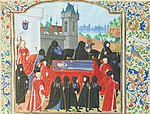Saint-Paul (Paris Métro)
Paris Métro line 1Paris Métro stations in the 4th arrondissement of ParisParis Métro stubsRailway stations in France opened in 1900Railway stations located underground in France

Saint-Paul (Le Marais) (French pronunciation: [sɛ̃ pɔl lə maʁɛ]) is a station on Paris Métro Line 1, close to the Rue Saint-Paul. It serves the neighbourhood of Le Marais, known for its Jewish and gay communities, and fine town houses. The Jewish quarter is called Pletzl and is located around the Rue des Rosiers. The Place des Vosges and the Lycée Charlemagne are nearby. The station was opened on 6 August 1900, 18 days after trains began running on the original section of line 1 between Porte de Vincennes and Porte Maillot on 19 July 1900.
Excerpt from the Wikipedia article Saint-Paul (Paris Métro) (License: CC BY-SA 3.0, Authors, Images).Saint-Paul (Paris Métro)
Place des Combattantes et Combattants du Sida, Paris 4th Arrondissement (Paris)
Geographical coordinates (GPS) Address Nearby Places Show on map
Geographical coordinates (GPS)
| Latitude | Longitude |
|---|---|
| N 48.855214 ° | E 2.360859 ° |
Address
Saint-Paul
Place des Combattantes et Combattants du Sida
75004 Paris, 4th Arrondissement (Paris)
Ile-de-France, France
Open on Google Maps










